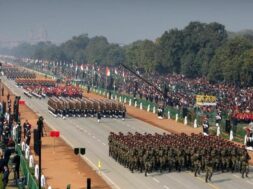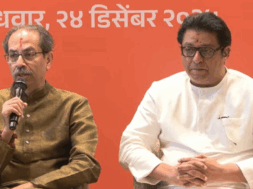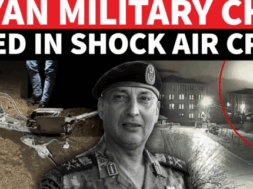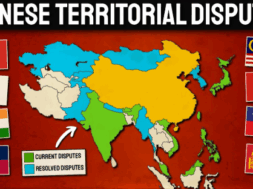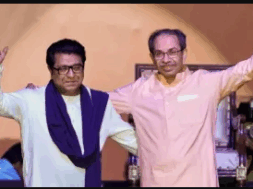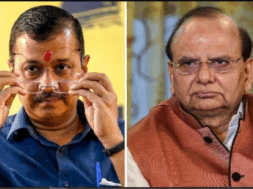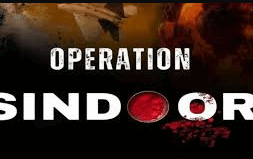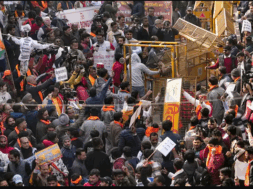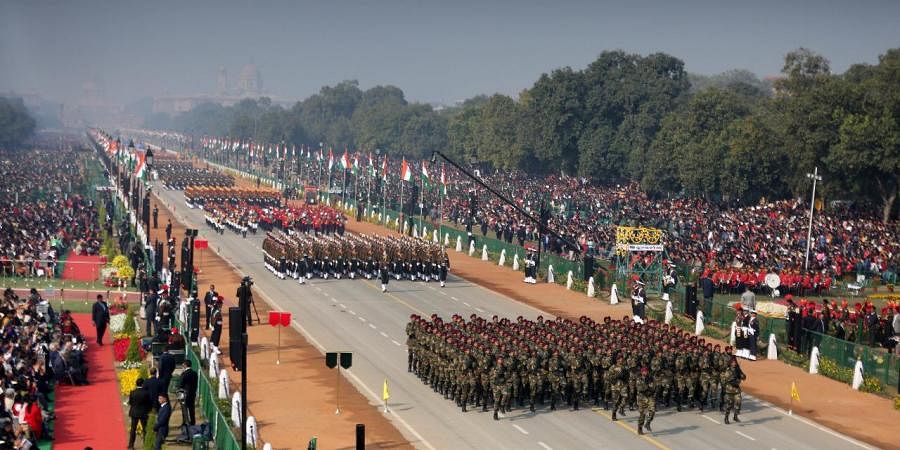
Manas Dasgupta
NEW DELHI, Jan 26: Amidst very tight security with over 27,000 policemen deployed in the national capital, the grand flypast by a fleet of 75 aircraft to mark the “Azadi ka Amrut Mahotsav” (75 years of Independence) was the highlight of the otherwise subdued 73rd Republic Day parade under the shadow of the Covid pandemic on the Rajpath on Wednesday.
Known otherwise to witness huge bustling crowds across many age groups, the annual ceremonial event at Rajpath was drastically scaled down this time in view of the coronavirus pandemic with only 24 Tableaux, including 12 from various states and union territories, nine of the central ministries and three of the defence establishments highlighting dances, spirit of sportsmanship, biodiversity, the freedom struggle, religious destinations and development taking part in the parade. The spectators’ size was drastically cut to 5000 from the 25,000 last year. In the pre-pandemic times, over one lakh spectators used to witness the parade.
From members of contingents to spectators, everyone wore masks. The audience maintained the mandated distance while sitting, and standing spectators were not allowed. Only double vaccinated adults and children above the age of 15 who have taken at least one dose of a COVID-19 vaccine were allowed to enter the venue. There was tight security with personnel maintaining strict vigil. Chairs were placed at a distance to ensure social distancing. Participants also received a white cap with “Azadi ka Amrut Mahotsav” printed on it.
The grand flypast by 75 aircrafts was one of the biggest attractions of the celebrations which was held for the second consecutive day without a foreign leader as the chief guest. The celebrations began with the prime minister Narendra Modi paying tributes to the fallen soldiers at the National War Memorial before the president Ram Nath Kovind took the salute at the parade as it marched past grandeur “Rajpath” in the national capital displaying India’s military might and vibrant cultural heritage.
Showcased at the Republic Day parade were the Centurion tank, PT-76 tank, 75/24 Pack howitzer and OT-62 TOPAZ armoured personnel carrier that played a major role in defeating Pakistan in the 1971 war.
India in 2021 celebrated the Swarnim Vijay Varsh (Golden victory year) to commemorate the country’s win over Pakistan in the 1971 war that led to the creation of Bangladesh. The mechanised columns of the Army showed one PT-76 tank, one Centurion tank, two MBT Arjun MK-I tanks, one OT-62 TOPAZ armoured personnel carrier, one BMP-I infantry fighting vehicle and two BMP-II infantry fighting vehicles.
Defence Minister Rajnath Singh and the three service chiefs were present at the solemn ceremony as the prime minister laid a wreath at the NWM, a monument to the soldiers who have made supreme sacrifice for the country. The prime minister ditched his traditional turban look on Republic Day this year and wore a traditional cap from Uttarakhand with an image of the brahmakamal, the state flower, and also sported a stole from Manipur.
There was no chief guest at the parade this year. However, sanitation workers, frontline workers, auto rickshaw drivers, construction workers and labourers who prepared the majestic tableaus were among special guests invited this year to the Republic Day parade.
The parade started at 10:30 am this year, half-an-hour later than usual for better visibility due to the cold winter day in Delhi. Commanded by Lt Gen Vijay Kumar Mishra, with Maj Gen Alok Kacker as the second-in-command, the parade began with President Ram Nath Kovind taking the salute. The national flag was unfurled followed by the national anthem, synchronised with a 21-gun salute.
Horse-mounted soldiers of the Indian Army’s 61 Cavalry Regiment, the only active horsed cavalry unit in the world currently, was the first marching contingent at the parade. This regiment’s contingent was led by Major Mrityunjay Singh Chouhan. The parade saw the launch of ‘Shaheedon Ko Shat Naman’ programme by the National Cadet Corps and a display of ten scrolls each of 75 metres prepared during the ‘Kala Kumbh’ event besides installation of 10 large LED screens for a better viewing experience of spectators.
The Navy’s tableau was the first to come down on Rajpath on a frigid Wednesday morning and depicted two main themes. First, the 1946 naval uprising, which was a part of the freedom struggle, and against the terrible conditions of the Indian sailors who were a part of the British Indian Navy and the second on the “atmanirbharta” of the Navy, with a model of the country’s first indigenous aircraft carrier, which will be commissioned later this year and named INS Vikrant.
The Air Force tableau paid homage to the victory over Pakistan in the 1971 War, with models of MiG 21, Gnat — both of which were used in the war — and the Light Combat Helicopters. DRDO showcased major weapon platforms developed by it, including the Light Combat Aircraft Tejas and an Air Independent Propulsion system it is working on for the submarines.
The contingents of security forces were followed by tableaux from states that showcased India’s cultural diversity, with themes ranging from the freedom struggle to biodiversity. Several government ministries and departments also took out tableaux, highlighting flagship initiatives such as the Jal Jeevan Mission. The Central Public Works Development tableau paid tribute to Netaji Subhas Chandra Bose on his 125th birth anniversary.
The Lok Adalat tableau made its debut on Rajpath this year. The theme of the float by National Legal Services Authority was “Ek Mutthi Aasman (Inclusive Legal System): Lok Adalat”. The front part of the tableau showcased ‘Nyay Sabke Liye’, a hand gesture of fearlessness, guarantee and protection.
Martyrs and independence movement was the theme of poll-bound Punjab’s tableau while the Department of Post’s tableau displayed the robust outreach and the modern face of India Post as well as all-women post offices to showcase the steps taken towards gender equality.
From the states and UT, Meghalaya came out with its tableau first, showing the importance of women-led cooperative societies and self-help groups, with bamboo and cane handicrafts, as it celebrated its 50th year of statehood. Karnataka too, highlighted the traditional handicrafts from the state, calling itself the “cradle of traditional handicrafts” with 16 artefacts on inlay carving, lacquerware toys and bronze statues possessing the Global Indicator tag.
Gujarat, like many others, highlighted the freedom movement, but through the role of the tribal population. It showcased the incident of the military killing around 1,200 people in March 1922 as Bhil tribes from Paal and Dadhvav villages had gathered to protest against the land revenue system under the leadership of Motilal Tejawat. Punjab also brought out the state’s “immense contribution” during the freedom movement with Bhagat Singh, Sukhdev and Rajguru leading from the front.
Dancers from the Kunbi community, the original inhabitants of Goa, and glimpses from the liberation struggle were the highlight of the tableau of the coastal State while Karnataka’s skillfully made pots, carefully sculpted sandalwood miniatures and rich tradition of handicraft were on display in the state’s tableau. Haryana had a simplistic tableau with several sportsmen from the state on a “victory chariot” carrying the national flag. The idea was to highlight that although it occupies only 1.3 per cent of the country’s landmass and 2.09 per cent of the population, sportsmen from the state have brought maximum medals for the country in various international sporting events, including the Olympics.
Uttarakhand portrayed the development in the state, highlighting the increasing connectivity between the various religious sites and Jammu and Kashmir showed the rapid pace of development in the UT, with the new IIT, IIM, AIIMS and an airport that are coming up there. Arunachal Pradesh depicted the four Anglo-Abor Wars between 1858 and 1912 during which the indigenous tribal people of the state, particularly the Adis from the Siang area, fought against the colonial expansion of the British.
Chhattisgarh portrayed the state’s Godhan Nyay Yojana for better use of rural resources, while Uttar Pradesh’ tableau showcased the One District One Product scheme of the government for the micro, small and medium enterprise industries and also the development of the Kashi Vishwanath Dham in Varanasi.
Maharashtra showed the rich biodiversity of the state, with 15 animals and 22 plants as a part of the tableau, including large models of the Blue Mormon Butterfly and more. From the Central government, the Education and Skill Development ministries highlighted the National Education Policy, the Civil Aviation Ministry showed the UDAN scheme, Department of Posts, showed Indian post at 75 years of Indian Independence, Home Affairs highlighted the valour and sacrifice of the CRPF, Central Public Works Department under Housing and Development Ministry showed Netaji Subhash Chandra Bose, Department of Justice highlighted the Lok Adalat and inclusive legal system, Department Drinking Water and Sanitation showcased the Har Ghar Nal under Jal Jeevan Mission, and the Culture Ministry highlighted 150 years of Aurobindo Ghosh.
Delhi was brought under a heavy security cover as the city police had intensified patrolling and sealed the borders of the national capital in coordination with its counterparts from the neighbouring states to thwart any untoward incident amid a terror alert by intelligence agencies. Over 27,000 police personnel were deployed on Republic Day security duties in Delhi and anti-terror measures intensified.
—————————-
